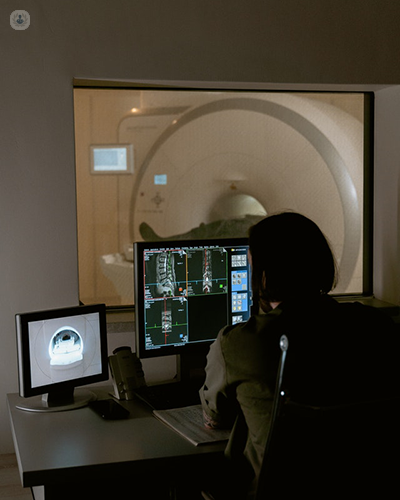Psoriasis, keloid scarring, arthritis and many more: Could radiotherapy be the answer?
Escrito por:Innovations and advances in treatment are continuously offering improved outcomes for patients and psoriasis, arthritis and keloid scarring are just some of the many conditions that can now be treated with low doses of radiotherapy. Leading radiotherapy specialist and consultant clinical oncologist Dr Richard Shaffer sheds light on the latest applications of cutting-edge radiotherapy treatments in this expert guide.

What is radiotherapy?
Radiotherapy is the use of X-rays and other types of radiation to treat disease. It is used in high doses to treat patients with cancer, as it stops it growing and kills the cells. It can also be used with much lower doses to treat non-cancerous (benign) conditions.
What non-cancerous conditions can radiotherapy be used to treat?
There are many benign conditions that can be treated with radiotherapy. These include, but are not limited to:
- hyperproliferative conditions
- osteoarthritis and tendinopathy
- benign skin conditions
Hyperproliferative conditions
Hyperproliferative conditions relate to tissue overgrowth, such as Dupuytren’s disease of the hand, Ledderhose disease of the foot and keloid scarring. In these cases, radiotherapy is used at half (or less) of the dose used to treat cancer. It reduces the tissue overgrowth to lessen pain and the size of the lumps and stops the condition coming back or getting worse.
In early Dupuytren’s disease, the fingers are still able to straighten fully or at least partially. When the patient is experiencing pain or their condition is worsening, radiotherapy is the only effective option to stop the disease progressing and forming a contracture of the fingers. Surgery can only be recommended at a later stage to release a contracture, which is a fixed bending of the fingers.
To treat keloid scarring, surgery is needed to remove the scar itself. Radiotherapy given within 1-2 days following this procedure is the most effective treatment to stop the keloid scar growing back.
Osteoarthritis and tendinopathy
Radiotherapy can be very useful in osteoarthritis and tendinopathy cases where there is inflammation or wear and tear. This form of treatment may be considered for patients with osteoarthritis of various joints including the shoulder, elbow, hand, wrist, hip, knee, foot as well as tendonitis of the elbows, shoulders or fingers. For these conditions, a very low dose of radiotherapy is used; around five per cent of the dose used for cancer. This reduces inflammation, which consequently lowers pain and increases function in the joint.
For arthritis in the hand, hip, knee, shoulder, elbow and foot, standard treatments such as medicines and steroid injections tend to be ineffective and can cause significant side-effects. Radiotherapy, however, has an eighty-five per cent chance of reducing pain and increasing function with minimal side effects.
Benign skin conditions
Troublesome areas of benign skin conditions such as psoriasis, eczema of the hand and foot and disseminated superficial actinic porokeratosis (DSAP) can be treated by low energy X-rays. This is particularly useful for conditions such as scalp psoriasis, which is often very difficult to treat with topical treatments such as creams. Radiotherapy is a very effective treatment, with a greater than eighty per cent chance of clearing the disease without causing hair loss.
Similarly, eczema on the palms is often very distressing and painful. A course of radiotherapy treatments has more than an eighty per cent chance of clearing it and helping the patient get back to normal, pain-free activities.
Other applications of radiotherapy
Radiotherapy also has many applications in treatment for other conditions, such as heterotopic ossification and pigmented villonodular synovitis as it stops cells growing back after surgery. Conditions such as acoustic neuroma and trigeminal neuralgia can be treated with stereotactic radiotherapy (a high dose, highly focused type of radiotherapy) as an alternative to surgery.
Who is not suitable for radiotherapy?
Each condition has different eligibility criteria to be considered. For instance, patients with early stage Dupuytren’s disease can benefit from radiotherapy but in more advanced cases, patients who have a contracture of more than thirty degrees, radiotherapy is not effective.
There are a number of rare conditions, such as xeroderma pigmentosum and ataxia-telangiectasia, which give the patient an increased sensitivity to radiotherapy, making it unsafe to use.
What are the main reported side effects following radiotherapy treatment?
The side-effects of radiotherapy depend on the part of the body treated and the dose of radiotherapy used.
When we use an intermediate dose of radiotherapy (around half the dose used for cancer) to treat a condition such as Dupuytren’s disease of the hand, the patient may experience some skin redness, soreness and dryness shortly after radiotherapy. Most of the time these symptoms resolve themselves but some patients develop long term dryness as well as paleness of the skin and swollen blood vessels, known as telangiectasia. However, these tend to be very minor changes.
With very low doses of radiotherapy (around five to ten per cent of the dose used to treat cancer), such as those used for osteoarthritis and tendinopathy, patients will not experience any side effects.
Can radiotherapy be dangerous?
Another consideration to make is that radiotherapy has a very small chance of causing cancer in the area treated. In cases of skin cancer, the average time it takes for the cancer to develop following radiotherapy treatment is roughly twenty to thirty years.
The level of risk depends on various things including:
- the dosage of radiation used in the treatment
- the age of the patient
- the part of the body being treated
For instance, for a fifty year old man having one hand treated for Dupuytren’s disease, the lifetime risk of developing skin cancer (a type of cancer which doesn’t spread to other parts of the body) in the treated hand is between 0.02% and 0.1%. However, for younger patients or those seeking treatment in higher risk body parts, the individual risk must be discussed in detail with the treating doctor.
If you are suffering from one of the conditions mentioned in this article and would like to discuss the benefits that radiotherapy could offer you, don’t hesitate to visit Dr Shaffer’s Top Doctors profile where you can learn more about him and book a consultation.


